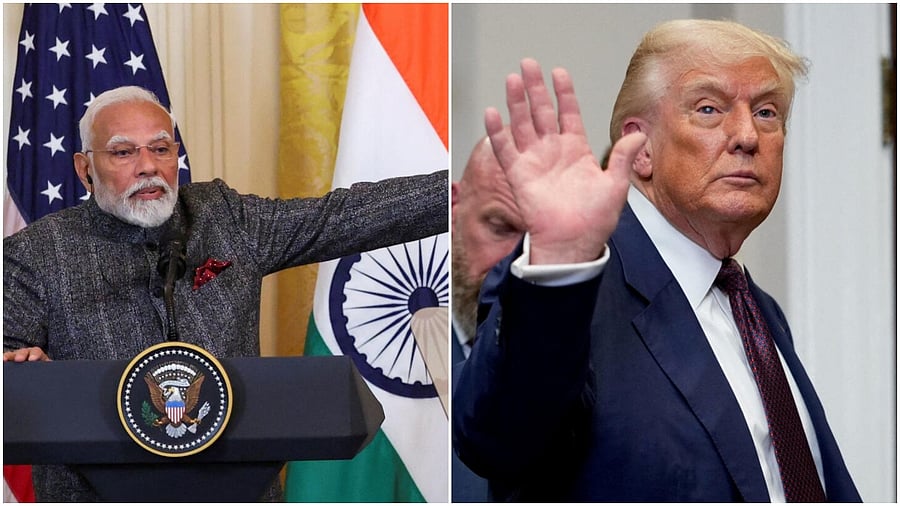
Narendra Modi(L), Donald Trump
Credit: Reuters File Photo
Andy Mukherjee for Bloomberg
What began as a US-China trade war has suddenly turned into an open and ugly confrontation between Washington and New Delhi. Donald Trump has escalated the conflict, but the onus for defusing it is squarely with Narendra Modi — and both sides know it.
With two days to go before the US president’s reciprocal trade taxes come into effect, he’s doubling down on his threat to impose a “substantially higher” tariff on India than the 25% already announced.
The White House is accusing the most-populous nation of funding Vladimir Putin’s war machine in Ukraine by buying Russian oil, a characterization that the Indian prime minister has decided to contest. “The targeting of India is unjustified and unreasonable,” Modi’s ministry of external affairs said in a statement Monday. Affordable energy costs for Indian consumers are a “vital national compulsion.”
What’s puzzling about this game of chicken is this: Having previously ignored much bigger insults — such as Trump’s repeated claims of having brokered a ceasefire in New Delhi’s military standoff with Islamabad — why is Modi invoking wounded national pride at the last minute? Does this mean that India has given up any hope of a trade deal with the US?
In a speech in Uttar Pradesh Saturday, a defiant Modi announced: “We will buy those things which have been made by the sweat of an Indian.”
If that’s a rhetorical response to Trump calling India a “dead economy,” then that’s just both sides trying to gain leverage ahead of a deal. However, if it’s a veiled threat to Washington to stop expecting any concessions on tariffs and non-tariff barriers, then it’s a strategic miscalculation.
Except for Modi’s diehard right-wing supporters, few in the salaried middle class care deeply about the country’s right to buy Russian oil. After all, what’s in it for them? Motorists in New Delhi were paying Rs 105 for a liter of gasoline at the start of Putin’s war. Now they’re paying Rs 95 but that’s only because 20% of what they’re putting in the tank is bioethanol. That doesn’t make for happy consumers. Two out of three respondents in a nationwide survey of 22,000 vehicle owners by LocalCircles, a New Delhi-based community engagement platform, complained of reduced fuel efficiency.
Contrast this with 1998. Back then, the Clinton administration sanctioned India for conducting a nuclear test. Foreign aid came to a standstill, and capital inflows nosedived. And yet, national opinion was largely in support of the government. The Indian diaspora bought billions of dollars of so-called Resurgent India Bonds to shore up the country’s foreign-exchange reserves. The US-India relationship entered a new phase of closer cooperation. Washington began to view New Delhi as a reliable ally to contain China’s rise.
That quarter-century-long reset is now in peril. So far, Modi’s policy of economic self-reliance has been all about curbing the $91 billion annual deficit with China. With the US, its largest export destination, India enjoys a $43 billion trade surplus. To not be in either camp would effectively mean a return to its socialist past, a long period of autarky and slow growth.
India supplies nearly half of the generic drugs consumed in America. Trump’s tariffs on pharmaceuticals, combined with his promise to slash prices for consumers, would force manufacturers to search for alternative markets — or they will have to relocate to the US. A botched goods-trade accord could also impair India’s software exports and cast a shadow over the brightest spot in the economy: the large investments by US multinationals looking to outsource research and product development to their captive units in Bengaluru and Hyderabad.
With so much at stake, Modi can’t afford to get embroiled in a war of words with Trump. His priority should be to avoid a penal US tariff, especially over an energy source that has zero political resonance at home. Now that Russia has come to account for a third of crude import — from barely 1% before the Ukraine war — it might take New Delhi some time to dial down the refiners’ enthusiasm. But a course correction has to be signaled to Washington.
Tellingly, one of the at least four tankers laden with flagship Urals crude currently anchored off India’s western coast is called the Achilles. However tactically crucial Russian oil may have been to India in 2022, it’s now a strategic vulnerability. Modi mustn’t make it his Achilles’ heel.